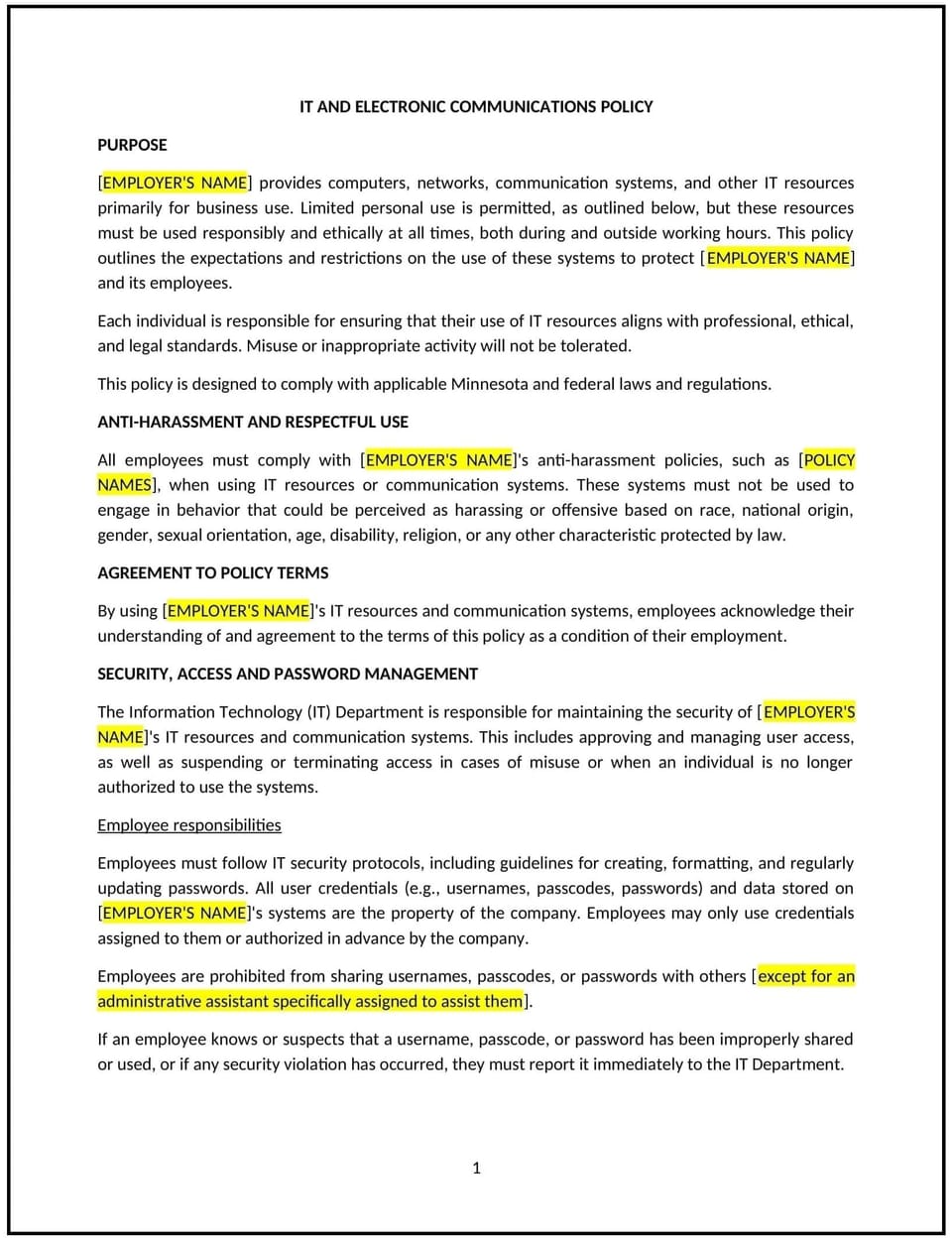IT and electronics communications policy (Minnesota): Free template

IT and electronics communications policy (Minnesota)
This IT and electronics communications policy is designed to help Minnesota businesses establish clear guidelines for the use of technology, electronic devices, and communication systems. Whether businesses are managing email, internet usage, data security, or remote work tools, this policy provides a framework to promote efficiency, security, and responsible use of IT resources. Tailored to Minnesota’s business environment, this policy emphasizes data protection, productivity, and compliance with organizational standards.
By implementing this policy, businesses in Minnesota can safeguard sensitive information, reduce risks, and ensure consistent and professional use of IT resources.
How to use this IT and electronics communications policy (Minnesota)
- Define acceptable use: Clearly outline acceptable and prohibited uses of IT resources, such as email, internet, software, and devices.
- Address data security: Provide guidelines for protecting sensitive information, including password management, encryption, and secure file sharing.
- Set expectations for communication: Establish standards for professional and appropriate use of email, messaging platforms, and other communication tools.
- Monitor usage: Outline the business’s right to monitor IT usage for security, compliance, and productivity purposes.
- Address remote work: Include guidelines for using IT resources in remote or hybrid work environments, such as VPNs and secure connections.
- Provide training: Educate employees on the policy’s guidelines, data security best practices, and responsible use of IT resources.
- Enforce consequences for misuse: Outline disciplinary actions for violations of the policy, such as unauthorized access or inappropriate use of IT resources.
- Review and update the policy: Regularly assess the policy’s effectiveness and make adjustments as needed to reflect changes in technology, business needs, or legal requirements.
- Communicate the policy: Share the policy with employees during onboarding and through internal communications to ensure awareness and understanding.
Benefits of using this IT and electronics communications policy (Minnesota)
This policy offers several advantages for Minnesota businesses:
- Protects sensitive information: Clear guidelines for data security help prevent breaches and unauthorized access to sensitive data.
- Promotes productivity: Establishing standards for IT usage ensures resources are used efficiently and for business purposes.
- Reduces risks: Addressing security and acceptable use minimizes the risk of cyber threats, data loss, or legal liabilities.
- Supports remote work: Guidelines for remote IT usage help maintain security and consistency in hybrid or remote work environments.
- Enhances professionalism: Standards for communication tools ensure employees represent the business professionally in all interactions.
- Builds trust: A transparent and fair policy fosters trust among employees and demonstrates the business’s commitment to security and accountability.
- Aligns with best practices: The policy reflects modern standards for IT management and data protection.
Tips for using this IT and electronics communications policy (Minnesota)
- Communicate the policy effectively: Share the policy with employees during onboarding and through regular training sessions.
- Provide IT training: Educate employees on data security best practices, responsible IT usage, and the policy’s guidelines.
- Monitor usage: Regularly review IT usage to ensure compliance with the policy and identify potential risks or inefficiencies.
- Be consistent: Apply the policy uniformly to all employees to avoid perceptions of favoritism or bias.
- Encourage feedback: Regularly seek input from employees on how the policy can be improved to better meet their needs and the business’s goals.
- Review the policy periodically: Update the policy as needed to reflect changes in technology, business needs, or legal requirements.
Q: Why should Minnesota businesses adopt an IT and electronics communications policy?
A: Businesses should adopt this policy to protect sensitive information, promote productivity, and reduce risks associated with IT usage.
Q: What should businesses include in an acceptable use policy?
A: Businesses should outline acceptable and prohibited uses of IT resources, such as email, internet, software, and devices.
Q: How can businesses protect sensitive data?
A: Businesses should provide guidelines for password management, encryption, secure file sharing, and other data security measures.
Q: What standards should businesses set for communication tools?
A: Businesses should establish expectations for professional and appropriate use of email, messaging platforms, and other communication tools.
Q: How should businesses handle remote work IT usage?
A: Businesses should include guidelines for using VPNs, secure connections, and other tools to maintain security in remote or hybrid work environments.
Q: How often should the policy be reviewed?
A: The policy should be reviewed annually or as needed to reflect changes in technology, business needs, or legal requirements.
Q: What role do employees play in enforcing this policy?
A: Employees should follow the policy’s guidelines, report potential security risks, and use IT resources responsibly.
This article contains general legal information and does not contain legal advice. Cobrief is not a law firm or a substitute for an attorney or law firm. The law is complex and changes often. For legal advice, please ask a lawyer.


